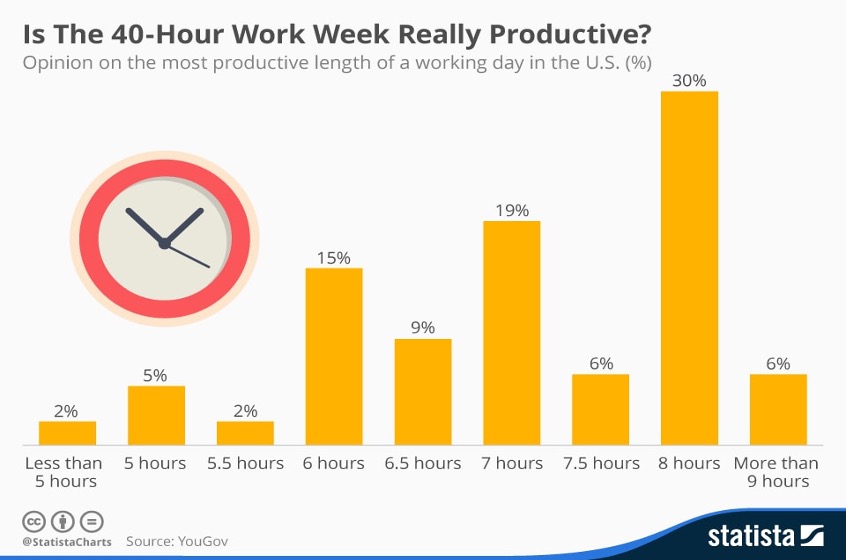The 40-hour work week has always been trending in most of the workplaces for a long time. But, in the past decades, the world has changed a lot, especially after the spread of coronavirus, the working trends and norms have transformed. 40-hour work week is getting non-functional in most of the firms these days. But the question is, what will be the best replacement for this traditional working pattern?
Before searching for substitutes of 40-hour work week, have you ever thought about what a 40-hour work week model is? Why it is considered a standard for a professional since long ago? Where did this concept originate? What of its features is making it redundant in the firms now?
Let’s have a quick overview of the facts about 40-hour work week.
What is a 40-hour work week?
The 40-hour work week is measured as the standard amount of time an employee has to work for its corporation in a week.
Background of 40-hour work week
The 40-hour work week is fixed as a working standard for employees in 19th century.
- In 1817, the labor unions united to demand reforms in employment conditions because people worked 80 to 100 hours per week for their organizations.
- In 1866, the National Labor Union filed a petition to Congress for the eight-hours workday as a law. As the Congress didn’t agree for this law, it moved more people to support the labor reforms.
- In 1869, President Ulysses S. announced an eight-hour workday for the government employees, which encouraged the private sector employees to demand the same rights.
- In 1886, the Illinois Legislature passed a law for eight-hour workdays for this year only. But, a massive crowd of employees refused this law and held a strike in Chicago. A bomb exploded on this crowd, and 12 people were killed. It resulted in Haymarket Riot and is now observed as a public holiday for ‘May Day’ on 1st of May every year.
- In 1926, Henry Ford introduced the 40-hour work week. After research, he concluded that working more than 40 hours per week has less impact on productivity.
- In 1938, a revolutionary law was passed by Congress, known as the Fair Labor Standards Act, stating that all the employees who work for more than 44 hours will be paid overtime for their work. After two years, they amended the act to reduce the work week up to 40 hours.
- In 1940, the 40-hour work week became a permanent part of U.S. law.
Productivity of 40-hour work week
The productivity of 40-hour work week model depends on an employee’s capabilities. Most companies standardize the 40-hour work week model as eight-hour workdays, five days per week for all the employees. But is this rule effective for each employee?
Each person has their way of working. Besides it, many other factors like a person’s life stressors, his skill level make it difficult to set the same productivity level for all employees. To know the effectiveness of a 40-hour work week, we must understand how an employee utilizes those eight hours per day in the workplace. Let’s have a rundown of some facts and figures on it.
- According to a recent survey from AtTask, this is how the employees spend their eight-hour per day at work:
- 45% of the time is consumed in primary job duties.
- 40% of it is passed in meetings, administrative tasks and ‘other interruptions.’
- 14% of it is spent on E-mails.
- Christopher Barnes, an associate professor at the University of Washington, says that an average worker is productive only for almost three hours a day.
A study of 2,000 full-time employees authenticates this research. It shows that out of 8 hours, i.e. 480 minutes of work, an employee is productive for less than half of this time for the office work, and the rest of the time is passed in following the activities.
- 60 to 65 minutes in reading news websites.
- 44 minutes on social media.
- 40 minutes in gossiping with coworkers.
- 26 minutes in searching a new job.
- 23 minutes for smoking breaks.
- 18 minutes on phone calls to friends or partners.
- 17 minutes while making hot drinks.
- 14 minutes in messaging.
- 8 minutes in snacking.
- 7 minutes on food preparation at the office.
These statistics show that most employees do not achieve 100% productivity in a 40- hour work week at their workplace. But, a few diversions help in the refreshing of mind, which increases an employee’s focus. The creativity level of employees is also enhanced by increasing the workplace wellbeing and making it a better place for employees to work.
Case study supporting 40 – hour work week strategy
A New Zealand based financial services company, Perpetual Guardians, claims a 20% improvement in their throughput after applying a 40 – hour work week. They said that more companies should stick to it to see a surprising increase in their company’s efficiency and staff and improvement in their wider community. After implementing the 40 – hour work week, the employees’ stress level is decreased by 7% and it also helped increase the employee well-being.
Another case study on an American company shows the following results for the productivity of 40-hour work week.
It shows that the company achieved its maximum throughput when the employees worked eight hours a day, five days per week.
Pros of 40- hour work week
- It reduces the stress on an employee due to fixed working hours.
- Reduction in work time contributes to higher productivity.
- Employees will work in a more relaxed environment resulting in the timelier deliveries of the projects.
- The commute cost is saved.
Cons of 40 – hour work week
- The advent of technology is making this hour system non-functional for many industries.
- These fixed short time slots lead to low-quality work when there is more work in a short span.
- It discourages teamwork as each employee wants to work alone according to their comfort zone and does not want to work with coworkers.
- As ladies are also into workplaces these days, so if both the partners are working according to 40 – hour work week, they may have less family time, leading to clashes in the relationships.
Alternatives to 40 hours work week
As virtual machines and technology have taken over the world, we should move on to a new and improved workplace strategy. Some of these strategies that can replace 40-hour work week are as follows:
· Flextime
It provides the employees with the option of designing their own work schedules, ensuring that they are present in the official meetings and activities.
· Telework
Telework is a better option for employees who don’t want to work a regular 40-hour week. It allows the employees to work one to five days a week from home or anywhere remotely.
· Compressed work week
A compressed work week consists of four ten-hour days instead of five eight-hour days. It benefits the employees to save one extra day from work. It also helps them to save income by lowering their commute costs.
· 32-hour work week
This strategy allows the employees to work for eight hours each day for four days a week while still having their full salaries. This approach accelerates business productivity while enhancing the employees’ competencies.
Conclusion
In the recent era, companies are experimenting with more standard workplace structures to increase the efficiency of their businesses. HR Consultancy firms suggest increasing employee engagement to improve organizational effectiveness, so it’s not just about being flexible in working hours. At the end of the day, it is all about aligning the values of the employees with the company’s needs and requirements.




 Bitcoin
Bitcoin  Ethereum
Ethereum  Tether
Tether  XRP
XRP  Solana
Solana  USDC
USDC  TRON
TRON  Cardano
Cardano  Lido Staked Ether
Lido Staked Ether  Avalanche
Avalanche  Toncoin
Toncoin